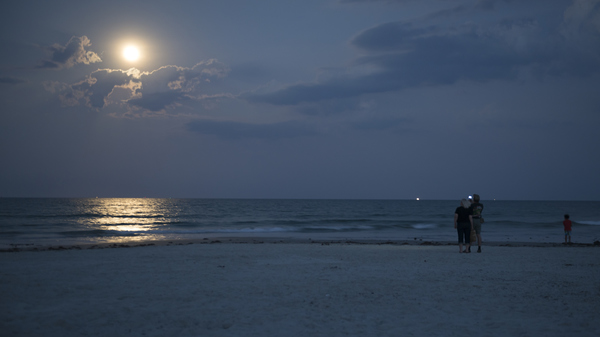See the Super Buck Moon in July
The second Supermoon of 2022—the Super Buck Moon—will grace our skies on July 13. Here are some tips on how to enjoy it.

The Buck Moon in July will be a Super Full Moon and can appear bigger and brighter than a normal Full moon. Pictured: the Full Moon over Cocoa Beach in Cape Canaveral, Florida, US.
©iStockphoto.com/Joel Carillet
When Is the Super Buck Moon?
The Full Moon on July 13, 2022 is known as the Buck Moon, and because it is very near Earth in its orbit, it is also a Supermoon.
To be precise, the exact time of the Full Moon is 18:37 UTC. The visibility of the Full Moon depends on the moonrise time in your location.
The Second Supermoon in 2022
“Like eclipses, Supermoons come in pairs,” says Graham Jones, timeanddate’s resident astrophysicist.
The Super Strawberry Moon in June was the first Supermoon of 2022.
“The reason Supermoons never come alone is to do with the number of days it takes the Moon to travel from its closest point to Earth, to its farthest point, and back again. That’s around 27.6 days,” Graham explains.
“This is similar to the time it takes the Moon to go from one Full Moon to the next, which is about 29.5 days. So if there’s a lunar month where the Full Moon is close to Earth, it will also be close in one of the neighboring months—giving us two, or sometimes three, Supermoons in a row.”
What Is a Supermoon?
A Supermoon is when a Full Moon takes place when the Moon is near its closest approach to Earth, known as perigee. At timeanddate, we define a Supermoon as a Full Moon that occurs when the center of the Moon is less than 360,000 kilometers (ca. 223,694 miles) from the center of Earth.
Everyone Can See the Supermoon
All you need to know to see the Super Buck Moon is your location’s moonrise and moonset times.
Full Moons rise around sunset and set around sunrise.
If you miss the Supermoon on July 13, you can still catch an almost Full Moon the next day. The Moon appears full in the days before and after the exact time of the Full Moon.
Our Moon is made of rock and metal

The Buck Moon in July 2021 as seen from Myrtle Edwards Park in Seattle, United States.
©iStockphoto.com/400tmax
Will It Be Cloudy?
Keep an eye on our weather reports for up-to-date predictions! A cloudy sky may cover the Moon, but a few clouds can make for a dramatic viewing.
5 tips to get that perfect Moon photo
Full Moon Close to the Horizon
A Super Full Moon can look up to 7% bigger than an average Full Moon and looks 14% bigger and 30% brighter than a Micromoon. But ‘normal’ Full Moons also look big and beautiful this time of year:
- The Full Moon swoops low across the summer night sky in the Northern Hemisphere. This is because the path of the Moon is affected by the Earth’s axial tilt away from the Full Moon and toward the Sun.
- Watching the Full Moon at moonrise or moonset lets you view it close to the horizon. This tricks our brains into thinking it is much bigger than it actually is: the Moon Illusion.